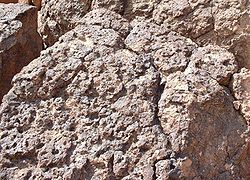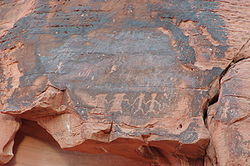
Desert varnish
Encyclopedia
Desert varnish, or rock varnish is a orange-yellow to black coating found on exposed rock
surfaces in arid
environments. Desert varnish is usually around one micron thick and present nanometre-scale layering . Rock rust and desert patina are other terms which are also used for the condition, but less often.
, fracturing or wind abrasion
. The varnish is primarily composed of particles of clay
along with iron
and manganese
oxides. There is also a host of trace elements and almost always some organic matter
. The colour of the varnish varies from shades of brown to black.
 Originally scientists thought that the varnish was made from substances drawn out of the rocks it coats. Microscopic and microchemical observations, however, show that a major part of varnish is clay, which could only arrive by wind. Clay, then, acts as a substrate to catch additional substances that chemically react together when the rock reaches high temperatures in the desert
Originally scientists thought that the varnish was made from substances drawn out of the rocks it coats. Microscopic and microchemical observations, however, show that a major part of varnish is clay, which could only arrive by wind. Clay, then, acts as a substrate to catch additional substances that chemically react together when the rock reaches high temperatures in the desert
sun. Wetting by dew
is also important in the process.
An important characteristic of black desert varnish is that it has an unusually high concentration of manganese
. Manganese is relatively rare in the Earth's crust, making up only 0.12% of its weight. In black desert varnish, however, manganese is 50 to 60 times more abundant. This significant enrichment is thought to be caused by manganese-oxidizing microbes (mixotrophs
) which are common in environments poor in organic nutrients
. A micro-environment pH
above 7.5 is inhospitable for manganese-concentrating microbes. In such conditions manganese-poor (Fe-rich) orange varnishes develop . An alternative hypothesis for Mn/Fe fluctuation has been proposed that consider Mn-rich and Fe-rich varnishes to be related to humid and arid climates, respectively
 Even though it contains high concentrations of iron and manganese, there are no significant modern uses of desert varnish. However, some Native American
Even though it contains high concentrations of iron and manganese, there are no significant modern uses of desert varnish. However, some Native American
tribes created petroglyph
s by scraping or chipping away the dark varnish to expose the lighter rock beneath.
Desert varnish often obscures the identity of the underlying rock, and different rocks have varying abilities to accept and retain varnish. Limestone
s, for example, typically do not have varnish because they are too water soluble and therefore do not provide a stable surface for varnish to form. Shiny, dense and black varnishes form on basalt
, fine quartzite
s and metamorphosed
shale
s due to these rocks' relatively high resistance to weathering.
Rock (geology)
In geology, rock or stone is a naturally occurring solid aggregate of minerals and/or mineraloids.The Earth's outer solid layer, the lithosphere, is made of rock. In general rocks are of three types, namely, igneous, sedimentary, and metamorphic...
surfaces in arid
Arid
A region is said to be arid when it is characterized by a severe lack of available water, to the extent of hindering or even preventing the growth and development of plant and animal life...
environments. Desert varnish is usually around one micron thick and present nanometre-scale layering . Rock rust and desert patina are other terms which are also used for the condition, but less often.
Formation
Desert varnish forms only on physically stable rock surfaces that are no longer subject to frequent precipitationPrecipitation (meteorology)
In meteorology, precipitation In meteorology, precipitation In meteorology, precipitation (also known as one of the classes of hydrometeors, which are atmospheric water phenomena is any product of the condensation of atmospheric water vapor that falls under gravity. The main forms of precipitation...
, fracturing or wind abrasion
Ventifact
Ventifacts are rocks that have been abraded, pitted, etched, grooved, or polished by wind-driven sand or ice crystals. These geomorphic features are most typically found in arid environments where there is little vegetation to interfere with aeolian particle transport, where there are frequently...
. The varnish is primarily composed of particles of clay
Clay
Clay is a general term including many combinations of one or more clay minerals with traces of metal oxides and organic matter. Geologic clay deposits are mostly composed of phyllosilicate minerals containing variable amounts of water trapped in the mineral structure.- Formation :Clay minerals...
along with iron
Iron
Iron is a chemical element with the symbol Fe and atomic number 26. It is a metal in the first transition series. It is the most common element forming the planet Earth as a whole, forming much of Earth's outer and inner core. It is the fourth most common element in the Earth's crust...
and manganese
Manganese
Manganese is a chemical element, designated by the symbol Mn. It has the atomic number 25. It is found as a free element in nature , and in many minerals...
oxides. There is also a host of trace elements and almost always some organic matter
Organic matter
Organic matter is matter that has come from a once-living organism; is capable of decay, or the product of decay; or is composed of organic compounds...
. The colour of the varnish varies from shades of brown to black.
Composition

Desert
A desert is a landscape or region that receives an extremely low amount of precipitation, less than enough to support growth of most plants. Most deserts have an average annual precipitation of less than...
sun. Wetting by dew
Dew
[Image:Dew on a flower.jpg|right|220px|thumb|Some dew on an iris in Sequoia National Park]]Dew is water in the form of droplets that appears on thin, exposed objects in the morning or evening...
is also important in the process.
An important characteristic of black desert varnish is that it has an unusually high concentration of manganese
Manganese
Manganese is a chemical element, designated by the symbol Mn. It has the atomic number 25. It is found as a free element in nature , and in many minerals...
. Manganese is relatively rare in the Earth's crust, making up only 0.12% of its weight. In black desert varnish, however, manganese is 50 to 60 times more abundant. This significant enrichment is thought to be caused by manganese-oxidizing microbes (mixotrophs
Mixotroph
A mixotroph is a microorganism that can use a mix of different sources of energy and carbon. Possible are alternations between photo- and chemotrophy, between litho- and organotrophy, between auto- and heterotrophy or a combination of it...
) which are common in environments poor in organic nutrients
Organic matter
Organic matter is matter that has come from a once-living organism; is capable of decay, or the product of decay; or is composed of organic compounds...
. A micro-environment pH
PH
In chemistry, pH is a measure of the acidity or basicity of an aqueous solution. Pure water is said to be neutral, with a pH close to 7.0 at . Solutions with a pH less than 7 are said to be acidic and solutions with a pH greater than 7 are basic or alkaline...
above 7.5 is inhospitable for manganese-concentrating microbes. In such conditions manganese-poor (Fe-rich) orange varnishes develop . An alternative hypothesis for Mn/Fe fluctuation has been proposed that consider Mn-rich and Fe-rich varnishes to be related to humid and arid climates, respectively

Native Americans in the United States
Native Americans in the United States are the indigenous peoples in North America within the boundaries of the present-day continental United States, parts of Alaska, and the island state of Hawaii. They are composed of numerous, distinct tribes, states, and ethnic groups, many of which survive as...
tribes created petroglyph
Petroglyph
Petroglyphs are pictogram and logogram images created by removing part of a rock surface by incising, picking, carving, and abrading. Outside North America, scholars often use terms such as "carving", "engraving", or other descriptions of the technique to refer to such images...
s by scraping or chipping away the dark varnish to expose the lighter rock beneath.
Desert varnish often obscures the identity of the underlying rock, and different rocks have varying abilities to accept and retain varnish. Limestone
Limestone
Limestone is a sedimentary rock composed largely of the minerals calcite and aragonite, which are different crystal forms of calcium carbonate . Many limestones are composed from skeletal fragments of marine organisms such as coral or foraminifera....
s, for example, typically do not have varnish because they are too water soluble and therefore do not provide a stable surface for varnish to form. Shiny, dense and black varnishes form on basalt
Basalt
Basalt is a common extrusive volcanic rock. It is usually grey to black and fine-grained due to rapid cooling of lava at the surface of a planet. It may be porphyritic containing larger crystals in a fine matrix, or vesicular, or frothy scoria. Unweathered basalt is black or grey...
, fine quartzite
Quartzite
Quartzite is a hard metamorphic rock which was originally sandstone. Sandstone is converted into quartzite through heating and pressure usually related to tectonic compression within orogenic belts. Pure quartzite is usually white to gray, though quartzites often occur in various shades of pink...
s and metamorphosed
Metamorphic rock
Metamorphic rock is the transformation of an existing rock type, the protolith, in a process called metamorphism, which means "change in form". The protolith is subjected to heat and pressure causing profound physical and/or chemical change...
shale
Shale
Shale is a fine-grained, clastic sedimentary rock composed of mud that is a mix of flakes of clay minerals and tiny fragments of other minerals, especially quartz and calcite. The ratio of clay to other minerals is variable. Shale is characterized by breaks along thin laminae or parallel layering...
s due to these rocks' relatively high resistance to weathering.
External links
- http://minerals.caltech.edu/FILES/VARNISH/ Desert Varnish
- Rock Varnish (desert varnish): An Internet Primer for Rock Art Research by Ronald I. Dorn, Professor of Geography Arizona State University
- DESERT VARNISH (rock varnish)
- New Way Suggested to Search for Life on Mars - Space.com
- Researcher: Mars rock varnish hints of life July 2, 2001 By Richard Stenger CNN
- Rock Varnish As A Habitat For Extant Life On Mars
- The Bibliography of Aeolian Research

